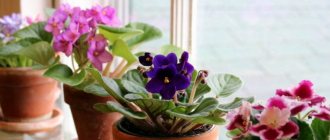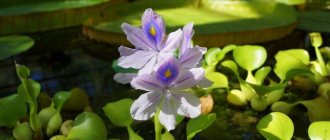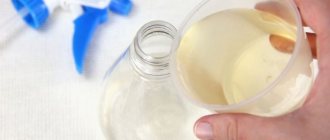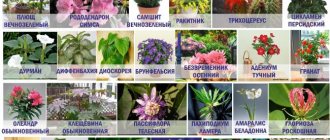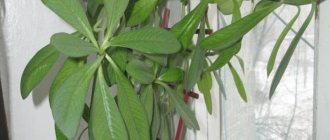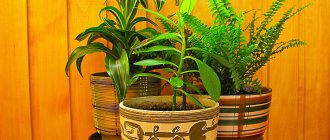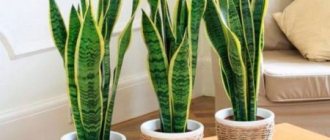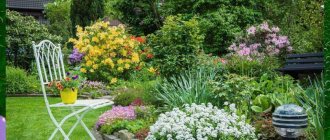Sansevieria (pike tail)
The plant, which is also called “mother-in-law’s tongue,” will give a head start to any humidifier.
Sansevieria grows in very dry places, and it has learned to produce a lot of oxygen from dry soil. Sansevieria can be safely planted even for lazy housewives who forget to water the flowers. And a life hack: if you add a little activated carbon to the soil, it will also clean the air.
Spathiphyllum - “female happiness”
Spathiphyllum is also called “women’s happiness.” It is an excellent natural humidifier that is able to draw toxins from the air, filling it with oxygen. Spathiphyllum works especially productively at night. It is important to warn: the plant must be kept away from children, because its leaves contain a large amount of toxic substances.
Chlorophytum
If you place several chlorophytums in one room, the air will be almost like in alpine meadows. A simple house plant fits perfectly into the interior and fills the apartment with fresh and clean air.
Moisture accumulates in the leaves and is released in large volumes, eliminating benzene and carbon monoxide. But don’t overdo it with seedlings, otherwise you risk turning your apartment into a greenhouse.
Which plants effectively humidify the air?
Indoor plants help create a microclimate that is comfortable for humans. They absorb water from the soil and release up to 90% of the moisture into the environment, spending only 10% of the absorbed moisture on their own internal processes. Evaporation of water leads to an increase in humidity in the room by 10-20%.
The following plants release water especially abundantly into the environment and increase the humidity in the apartment:
- dwarf ficus;
- sparmannia;
- nephrolepis;
- fatsia;
- hibiscus;
- dracaena.
Dwarf ficus
This fast-growing small-leaved climbing ficus bears little resemblance in appearance to other types of ficus. The plant comes from Japan and China, is very decorative, looks beautiful when grown in a hanging form. Dwarf ficus requires diffused lighting, abundant watering in summer, and a temperature of +20°C...+25°C. In winter, watering is reduced, the temperature is reduced to +12°C, and when it drops to +8°C, watering is stopped. If the temperature does not decrease in winter, then watering and spraying do not stop. In the spring, the ficus is transplanted into universal soil for indoor plants. They are easily propagated by cuttings, growing to the soil with adventitious roots.
Sparmannia
Indoor linden, as Sparmannia is otherwise called, evaporates a lot of moisture and needs watering, especially in summer. This perennial plant, native to Africa, reaches a height of 1.5 m, grows quickly, blooms in winter. Sparmannia takes root easily by cuttings, tolerates bright diffused light well, and can grow on northern windows. In winter, Sparmannia is kept at a temperature of +10°C...+12°C and watering is reduced.
Nephrolepis
Under natural conditions, Nephrolepis - plants of the genus of ferns, are found in the tropical forests of the western and eastern hemispheres. In indoor conditions, northern windows are preferred. Nephrolepis requires abundant watering and diffused light. Winter temperature +14°С…+15°С. In summer, it is advisable not to allow the temperature to rise above +24°C, and in hot weather, water and spray more often.
Fatsia
The homeland of Fatsia is the subtropics of Japan. An evergreen fast-growing shrub grows up to 1.5 m in two years. It reaches its maximum decorative value in cool rooms. At air temperatures above +20°C, it sheds its leaves. Requires bright diffused lighting, tolerates partial shade. The plant is replanted annually in the spring. Fatsia loves frequent spraying and propagates by layering and cuttings.
Hibiscus
The hibiscus plant (Chinese rose) is found naturally in the subtropics and tropics of Southeast Asia. At home it reaches 3 m, blooms for a long time in bright diffused light. Hibiscus is able to grow in partial shade, but does not bloom in low light conditions and responds well to abundant watering. Feeding with a sugar solution is useful for Chinese roses. Easily propagated by cuttings.
Dracaena
All types of dracaenas grow well on eastern and western windows. Plants are provided with diffused sunlight and shaded from direct rays. Maximum growth is observed in summer at temperatures up to +25°C, winter temperatures are not lower than +15°C. In winter, watering is reduced, and in summer, water and spray abundantly, preventing the soil from drying out.
Peperomia obtufolia
The decorative deciduous plant is classified as an evergreen ground cover. An elegant and beautiful perennial plant with elliptical leaves; in pots they resemble green pads. Peperomia obtufolia stores moisture well, which is why it is considered a hardy indoor plant. Loves partial shade and temperatures not lower than 16 degrees. Perfectly cleans the air from harmful impurities: benzene, formaldehyde and others. By releasing oxygen, it has an antibacterial and antiviral effect.
Dwarf ficus
This variety differs in appearance from other ficuses.
It is decorated with small leaves that grow very quickly. The plant was born in Asian countries: Japan and China. The shoots of the ficus are thin and branch very strongly. The dwarf plant looks great in hanging baskets and planters. It is better to keep it in a place with diffused lighting. Ficus loves humidity: it is necessary to water it frequently and abundantly at a temperature of about 20-25 degrees. It is also worth spraying the leaves regularly. The plant evaporates moisture well, so it can humidify the air. Ficus cleanses it of toxins and saturates it with oxygen. However, it is not recommended to place the plant in a nursery or bedroom, since at night it, on the contrary, absorbs oxygen.
Humidification of batteries
An equally popular way to increase air humidity is to humidify batteries. The easiest way is to hang heavy, moisture-absorbing fabric on them, such as terry towels. The main disadvantage of the method is its short duration - wet towels dry quickly, and you have to start all over again.
A bucket of water will help prolong the operation of the structure - secure one end of the towel to the radiator, and lower the other into the bucket. Adherents of original solutions can use a nice rug from Ikea: if you wet it and hang it on the radiator, it will dry for at least two days.
You can increase air humidity by placing containers with water in close proximity to the battery. The advantage of this method is its fairly high efficiency, the disadvantage is that containers (especially if they are large) take up a lot of space, and this design does not look aesthetically pleasing.
If you have the opportunity, buy a saturator - a water container that can be hung on a hook on the radiator. The saturator is compact, approximately 10 cm in height and 2–3 cm in width and looks very nice. It effectively humidifies the air; the main thing is to remember to add water as it evaporates.
IN THE PHOTO: Options for humidifying a central heating battery
Dracaena
There are two types: “Dracaena fringe”, it resembles a palm tree and reaches large sizes, and “Dracaena derema”, grows up to 3 meters, blooms with red flowers. The bush of the plant is good at purifying the air from trichlorethylene and benzene, which can enter the room through a window or when using a printer. Reduces formaldehyde content and humidifies the air.
It is necessary to purify the air, since harmful substances accumulate in the rooms in which we spend most of our lives, and we put our health at risk. Interestingly, all of the above plants were recommended by NASA for purifying and humidifying air on space stations.
Pelargonium
This plant has a healing effect, as it has a positive effect on the human nervous system. Pelargonium eliminates irritability and also improves the microclimate in the house.
In addition, the flower helps eliminate viruses, bacteria and fungi. It is best to keep pelargonium in the room you visit most often.
Miracle or legend: Samara local historians conducted an investigation into “Zoya’s Standing”
Pleated and print: how and with what to wear basic skirts in the warm season
They have money and power: types of men prone to cheating in relationships
Cypress
The cypress tree is considered a sacred tree in Japan as it is believed to collect the souls of the dead. These evergreen trees humidify the air and absorb impurities in the home. Some claim that cypress reduces the symptoms of migraines and headaches. In return, it requires shade and regular watering.
Bamboo Palm (Chamaedorea)
A fairly large flowerpot, ideal for a private home. For example, for a spacious hall, two large pots with bamboo palms will be enough. They love a warm atmosphere and do not shy away from low light. The plant expects slow growth and slight changes throughout the year. So she won’t have any problems with pruning. In order for a bamboo palm to grow symmetrically, its pot needs to be rotated around its axis from time to time.
Why is too dry air in the house harmful?
With low humidity in the room, if you stay there for a long time, the mucous membranes of the respiratory tract dry out. Because of this, they do not fully perform their protective functions. There is a sore throat, cracked lips, but the most dangerous thing is that pathogenic bacteria, which are always abundant in the air, easily penetrate through dry mucous membranes. This leads to frequent acute respiratory viral infections and influenza.
Schefflera
Objects made from natural materials (wood, leather, paper) suffer from low air humidity. They dry out, warp, and cracks appear.
Dry air is also unfavorable for beauty: the skin of the face and hands becomes dry, cracks and wrinkles appear.



